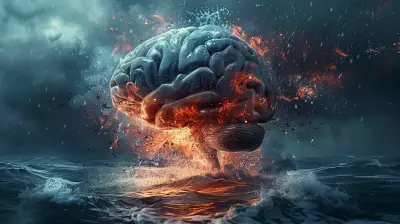The Power of EMDR Therapy in Trauma Healing
1 August 2025
When we think about trauma, we often picture those big, life-altering events—things like car accidents, natural disasters, or even war. But trauma can come in many forms, big or small, and it leaves a lasting imprint on our minds. For years, therapists have been trying to find ways to help people heal from these deep emotional wounds. One such method that has been gaining attention recently is EMDR therapy. You might be wondering, "What exactly is EMDR?" and "How does it work?" Well, buckle up, because we're about to dive deep into the world of Eye Movement Desensitization and Reprocessing (EMDR) and how it could be a game-changer for trauma healing.

What is EMDR Therapy?
EMDR—short for Eye Movement Desensitization and Reprocessing—sounds like something out of a sci-fi movie, right? But it's actually a highly effective, evidence-based therapy designed to help people process and heal from trauma. Developed in the late 1980s by psychologist Francine Shapiro, EMDR therapy helps people reprocess traumatic memories in a way that reduces their emotional intensity.The therapy involves a therapist guiding you through specific eye movements (or other forms of bilateral stimulation, like tapping or auditory tones) while you think about a traumatic event. Sounds simple, but it’s incredibly powerful. By doing this, you’re essentially rewiring the way your brain stores and processes these painful memories.

Trauma and the Brain: Why EMDR Works
To understand why EMDR is so effective, it helps to understand a little about how trauma affects the brain. When we experience trauma, our brains can get stuck in a "fight, flight, or freeze" response. The amygdala, the part of the brain responsible for our emotions and survival instincts, goes into overdrive. Meanwhile, the hippocampus, which helps process and organize memories, gets overwhelmed. As a result, those traumatic memories don’t get stored properly, and they can resurface at unexpected times, often leading to flashbacks, nightmares, or even physical symptoms like increased heart rate or sweating.In a nutshell, trauma creates a sort of "traffic jam" in the brain. EMDR helps to clear that jam. By engaging both hemispheres of the brain through bilateral stimulation (like the eye movements), the brain can reprocess the traumatic memory in a way that’s more manageable. The memory doesn’t disappear, but it loses its emotional sting. Think of it like defusing a bomb—EMDR removes the explosive power of the memory.

How Does EMDR Therapy Work?
EMDR therapy is typically done in eight phases, though the number of sessions can vary depending on the individual and the complexity of their trauma. Let's break down these phases so you can get a better idea of what to expect.1. History and Treatment Planning
In this phase, your therapist will gather information about your history, including past traumas and your current emotional state. Together, you’ll identify the traumatic memories or issues that need to be addressed. Don’t worry, it’s not about diving straight into the deep end; this is more like mapping out the pool before you take the plunge.2. Preparation
The preparation phase is all about getting you ready for the work ahead. Your therapist will explain how EMDR works and teach you some coping mechanisms, like mindfulness or visualization techniques, to help you stay grounded during the sessions. Think of it as packing your emotional toolkit.3. Assessment
Now, things get a bit more specific. You and your therapist will target a specific memory or event that’s been bothering you. You'll be asked to visualize the image associated with the trauma, identify the negative beliefs you hold about yourself related to the memory (like "I am powerless" or "I am unsafe"), and figure out what positive belief you’d like to adopt instead.4. Desensitization
Here’s where the magic happens. During this phase, the therapist will guide you through sets of eye movements (or other forms of bilateral stimulation) while you focus on the traumatic memory. The goal is to reduce the emotional charge of the memory. It’s a bit like playing a movie in slow motion—each time you watch it, it becomes a little less terrifying.5. Installation
Once the emotional sting of the memory has lessened, it’s time to "install" a positive belief. This process helps strengthen the belief you want to adopt, such as "I am in control" or "I am safe now." Think of it like updating the software on your brain—out with the old, and in with the new.6. Body Scan
Even after the memory has been reprocessed, our bodies can still hold onto trauma. The body scan phase helps you check for any lingering physical sensations, like tightness in your chest or tension in your shoulders. If anything comes up, the therapist will continue using bilateral stimulation until those sensations fade.7. Closure
At the end of each session, the therapist will help you return to a state of calm. It's like pressing the reset button. You’ll also be given tools and techniques to use between sessions in case any distressing thoughts or feelings come up.8. Reevaluation
In your next session, the therapist will check in with you to see how you’re feeling and whether the targeted memory is still causing distress. If it is, you may need to revisit it. If not, you’ll move on to the next memory or issue.
Who Can Benefit from EMDR Therapy?
EMDR is most commonly associated with trauma and PTSD (Post-Traumatic Stress Disorder), but its benefits reach far beyond that. Research has shown that EMDR can be effective for a wide range of conditions, including:- Anxiety
- Depression
- Panic disorders
- Phobias
- Grief and loss
- Addiction
- Chronic pain
So, even if you haven’t experienced a major traumatic event, EMDR can still be helpful for you if you're dealing with other emotional or psychological challenges.
The Science Behind EMDR: Does It Really Work?
You might be thinking, "This all sounds great, but does it actually work?" The short answer is: Yes, it does. EMDR is one of the most researched forms of trauma therapy, with numerous studies supporting its effectiveness. A 2014 meta-analysis published in The Journal of EMDR Practice and Research found that EMDR was just as effective—if not more so—than cognitive behavioral therapy (CBT) for treating PTSD.Moreover, the World Health Organization (WHO) and the American Psychiatric Association (APA) both recognize EMDR as an effective treatment for trauma and PTSD. So, while it may seem a bit unconventional, there's solid science backing it up.
How Does EMDR Compare to Other Therapies?
You might be wondering how EMDR stacks up against more traditional therapies like Cognitive Behavioral Therapy (CBT) or talk therapy. One major difference is that EMDR doesn’t require you to talk in detail about your trauma, which can be incredibly appealing for those who find it difficult to verbalize their experiences.Another key difference is that EMDR often works faster than other therapies. While traditional therapy can take months or even years to show progress, many people report significant improvement after just a few EMDR sessions. Think of it as a shortcut to healing—not because it skips steps, but because it takes a more direct route.
Is EMDR Right for You?
So, is EMDR the right therapy for you? The truth is, every person is different, and what works for one person might not work for another. However, if you’ve been struggling with trauma, anxiety, or other emotional challenges, and nothing else seems to be working, EMDR could be worth a try. It’s important to find a qualified therapist who is trained in EMDR and to keep an open mind. Healing is a journey, and EMDR might just be the tool you need to finally move forward.
Final Thoughts: The Power of EMDR Therapy
Trauma can feel like a wound that never quite heals. It leaves behind scars that can affect our thoughts, emotions, and even our bodies. But with EMDR therapy, there’s hope. By allowing your brain to reprocess traumatic memories, you can finally unshackle yourself from the chains of the past. It’s not an easy journey, and it’s not an overnight fix, but EMDR offers a unique and effective way to heal and reclaim your life.So, if you’re tired of carrying the weight of trauma, maybe it’s time to give EMDR a shot. Who knows? It could be the key to unlocking a lighter, freer version of yourself.
all images in this post were generated using AI tools
Category:
TraumaAuthor:

Christine Carter
Discussion
rate this article
1 comments
Icarus Larsen
EMDR therapy offers a transformative approach to healing trauma effectively and compassionately.
August 4, 2025 at 3:32 PM

Christine Carter
Thank you for your insightful comment! EMDR's compassionate approach truly makes a significant difference in trauma healing.


